A Distributed Multi-Tier Emergency Alerting System Exploiting Sensors-Based Event Detection to Support Smart City Applications
Abstract
1. Introduction
- Distributed detection and alerting of emergency situations through a multi-tier architecture.
- Separation of critical events and emergency alarms, which are processed individually and by different logical units.
- Definition of critical events as logical (ON/OFF) parameters, while emergency alarms are defined as having a numerical magnitude within a considered range.
- Computation of the impact of emergency alarms based on three distinct elements: Number of detected events, spatial information (modelled as “risk zones”) and temporal significance.
- Delivery of emergency alarms in a distributed and flexible way, attending any requesting application. The alarms are delivery in an open standard format.
- A reference implementation of all logical units, which was created for the Raspberry Pi platform and is available at https://github.com/lablara/cityalarm.git.
2. Related Works
- Monitoring scope: How many emergency situations can be detected?
- –
- Previous works: Several research and development works have proposed solutions to detect a single or a limited number of emergency situations, since a lot of systems have been developed around a pre-defined number of sensor types. For example, the work in [15] exploited sensor nodes to detect flood in homes, raising an alert when there is a water leak. For that, a sensor device was designed to detect a critical flood emergency. While such works can operate efficiently, they have limited application and a smart city scenario may need to deploy a group of different systems to accomplish a comprehensive and unified emergency detection solution.
- –
- Proposed approach: As the proposed CityAlarm solution is a multi-tier emergency detection and alerting system designed to handle any type of emergency situation, it can be considered as a unique solution for an entire city, potentially avoiding compatibility and inter-operation problems that may arise when multiple different systems are concurrently operating.
- Emergencies’ significance: What is the impact of detected emergencies?
- –
- Previous works: There has not been a consensus on the significance of detected emergency situations in the literature, with different approaches giving different perceptions of it. The work in [16] employed a wireless sensor network to alert people to a fire emergency in smart homes in a quick and effective way. Employing temperature, gas and smoke sensors to increase effectiveness and confidence, this approach is efficient when detecting a “fire” emergency. However, an emergency according to [16] is an ON/OFF variable and all detected emergencies are the same, regardless of where or when they happen. Nevertheless, an emergency can also be alerted providing additional information, as in [17]. In that work, sensors are used to alert people when the pollution level is above a defined threshold, but the level of pollution is also made clear. A lot of works have proposed different solutions when alerting to emergencies, which may be performed with the provision of different types of information.
- –
- Proposed approach: The CityAlarm system extends the perceptions of emergencies’ significance, associating three different groups of information: Number of detected events, risk area and temporal relevance. This is possible because CityAlarm is not dedicated to addressing a particular emergency (flooding, fire, natural disaster, etc), but any possible emergency that can be measured using sensor devices. Additionally, the concepts of “events” and “emergencies” are formally separated in CityAlarm, which allows the addition of new elements to the perception of emergencies. In this particular case, the perception of critical events and the associated definition of emergencies have been frequently coupled in emergency management systems [18,19]. In a different way, the detected emergencies in CityAlarm are associated with a numerical value within a range and such a value is computed based on those three groups of information. As a consequence, the proposed approach becomes more flexible and comprehensive in being adopted in any emergency detection and alerting scenario.
- Configuration of the system: How easy is its configuration and re-configuration?
- –
- Previous works: This characteristic varies considerably, but it is reasonable to say that most systems can be easily configured when properly defined for that purpose. The limitations that may arise then do not result from their configurations, but from the expected services of the systems. For example, if a fire detection system is designed, it is expected to be easily configured concerning such variables (thresholds, detection range, messages recipients, etc), but other variables (such as noise and pollution) may not be easily configurable (or not configurable at all). The configuration of those systems has been facilitated with the adoption of flexible open-source hardware platforms, such as Raspberry Pi and Arduino, a recent trend that influenced CityAlarm. In [20], the authors proposed a rainfall emergency notification solution to alert people to critical situations, using the Raspberry Pi platform to detect them. Besides sensing the rain level, the created nodes can perform predictions about upcoming heavy rain, which could be easily reconfigured or adapted for different scenarios.
- –
- Proposed approach: In order to adapt to the particularities of the different monitoring scenarios, the CityAlarm system was designed to be easily configured and re-configured, following a trend found in the literature. The proposed system is modularized for better adaptation to different monitoring scopes, making it easy to define events of interest, emergency alarms and risk zones. Moreover, the JSON format was adopted for the creation of the system’s messages, this concept being borrowed from web-based applications. Doing so, the messages transmitted between the CityAlarm units cannot only be easily changed, but it also facilitates the processing of the messages by other systems. Finally, the development of a proof-of-concept based on the Raspberry Pi platform follows a recent trend in the literature [13,21], facilitating the development of practical applications based on the proposed system.
- Scalability: How scalable is the emergency detection and alerting system?
- –
- Previous works: Scalability is a desired characteristic for some scenarios, especially for modern large cities. However, it may be hard to achieve in many cases. For systems dedicated to addressing a specific emergency situation in a defined scenario, for example fire detection in a residence[16], scalability may not be a concern, as such systems will operate individually. However, some solutions may cover large areas that may even change during the operation of the system. For example, the work in [22] defines a wireless sensor network to collect information about rainfall in different places and, using the cellular network, eventually alerting people to heavy rainfall as an emergency. In such a system, scalability may be a concern when many sensor units are deployed and have to deliver real-time information. In the literature, scalability issues have guided the development of some systems for emergency detection, usually defining multiple logical tiers for detection of critical situations and processing of alarms [23,24], influencing the development of CityAlarm.
- –
- Proposed approach: Having scalability as a fundamental characteristic, the proposed system was designed to detect, to process and to alert people to emergencies through different logical tiers, this concept being borrowed from recent works on IoT-based monitoring. Moreover, the separation of the concepts of “events” and “emergencies”, which are processed in different logical tiers, also reinforces the scalable nature of the proposed system. The expected scalability of the proposed system needs to be properly evaluated, but the modularized operation of the system following some recent trends is a good indication in this direction.
- Warning messages: This is the most obvious form of notification. When a critical event is detected and an emergency alarm is assembled, systems may send different types of messages to alert users about what is happening and possibly the level of criticality of the emergency. Such an alert may be a textual message, an audio warning or even an informative video. For example, users are alerted by GSM (global system for mobile communication) messages transmitted to their smartphones in [16]. In a different way, in the work presented in [15], a siren was used for audio alerting, besides textual messages.
- Rescue and exit paths: When using complementary information, an emergency alarm can be exploited to define rescue and evacuation paths for people in danger. For the work in [25], an analytical model was defined to compute the fastest escape route when an emergency is signalled. For that work, different information is crossed to achieve the most efficient route for people in danger. In [26], sensor nodes were used to identify safe exit paths during an emergency situation since sensors may be in a hazard or non-hazard mode according to the detection of a previously expected critical event. In both cases, users interact with the system through the definition of exit paths.
- Actuation and counter-measures: Some works have focused on acting to solve a particular emergency situation by removing its causes, resulting in a class of applications for disaster recovery. In such cases, an emergency alarm is an input for a recovery (concurrent) system, driving some counter-measure. In [27], detected emergencies were exploited to trigger mobile actuators, which are moved toward the sensors that detected the related events. Such actuator nodes may then gather additional information of the emergency or even do something to eliminate the cause of the detected events. In [28], sensor nodes were used to detect dangerous gas. When gas is detected, actuators are employed to isolate the gas leak source through the manipulation of gas valves. In both cases, the actuator system is complementary and concurrent to the emergency detection solution.
- Configuration of systems: An emergency alarm may also be realized as a configuration parameter for concurrent systems. Exploiting this type of information, a system can operate due to simple configurations, such as switching a sensor node from idle to active mode, or even determining how sensors will gather and process information from the environment. In [29], critical events were detected by sensor nodes, which exploited such information to configure their own sensing operation (transmission pattern, visual data sampling, media coding and QoS-based routing) during the time the event was still assumed as detected. The idea is to increase the level of details of retrieved data during an emergency, even consuming more energy and resources if necessary. The work in [30] considered the occurrence of critical events to change how logical clusters are created in the Medium Access Control (MAC) layer for more efficient communications during an emergency. QoS-based prioritization of sensor nodes has been addressed in recent years, it being a promising “client” for emergency management systems [12].
3. The Fundamentals of the Proposed Emergency Alerting System
3.1. Concepts and Basic Definitions
- Event of interest (EI): This is a critical “situation” that may put people in danger or may result in some relevant economic losses. We define that any event is directly mapped to a single “type” of sensed data that can be represented within a numeric scale. Thus, an EI will be associated to a single variable that can be measured by a particular sensor device, such as temperature, humidity, pressure, noise and luminosity, among others.
- Event report (ER): This is a description message indicating the types of all detected events of interest, along with the GPS coordinates where those events are detected and a timestamp mark. The event reports are created every time there is at least one change in the current list of detected events, in a hybrid synchronous/asynchronous way (described in Section 4), being transmitted toward the emergency processing unit. Every event report results in a single emergency alarm.
- Risk zone (RZ): When employing the CityAlarm system, the considered application area is expected to be divided into one or more risk zones. For simplification purposes, a risk zone is defined by a circular area and is associated to a numerical risk level. The association of a risk level to each RZ is a subjective decision that should take into account the risk factors for disasters, such as the number of people in the area and the presence of rescue and emergency response infrastructure. Each risk zone may contain zero or more event detection units.
- Emergency alarm (EA): This is the expected outcome of the CityAlarm system. An emergency alarm will be generated for each event report individually. Therefore, every EA message will contain the indication (“types”) of all events of interest presented in the ER. Moreover, the GPS coordinates (provided by the ER) will also be carried on emergency alarms, since they are required to determine the corresponding risk zone associated with the detected events, and applications may exploit such information. Together with the ER timestamp, a severity level (magnitude of the emergency) is also computed and inserted into the EA. All of this information can then guide different emergency actions, as reviewed in Section 2.
- emergency subscription (ES): This is a generic process performed by an external application that wants to receive emergency alarms from CityAlarm. While such a request may pass through some authentication process, it is out of the scope of this work, only being suggested in the case where emergency alarms are considered as confidential information. Nevertheless, the emergency subscriptions are expected to operate considering a broker-oriented architecture (described in Section 5).
3.2. Processing and Communication Units
- Tier events—event detection unit (EDU): This unit is the fundamental block of the CityAlarm system since it is responsible for the detection of events of interest, which are the defining conditions for an emergency alarm. An EDU is a multi-sensor unit that is capable of detecting as many different EI as there are sensor devices attached to it. Additionally, an EDU should be attached to a GPS device, allowing it to know its current location, but a cheaper implementation could manually configure the GPS coordinates into each EDU when setting them up. The GPS coordinates are required for the event reports that are transmitted by the EDU, indirectly matching any EDU to a risk zone. However, the concept of risk zone is unknown by the event detection units, being employed only by the EPU. Typically, there should be many EDUs spread over a smart city, increasing the precision and reach when detecting emergency situations;
- Tier alarms—emergency processing unit (EPU): This unit is responsible for receiving all event reports and processing them considering all defined risk zones (which are manually configured according to characteristics of the considered city) and the time scope configurations (also dependent on the considered city). Doing so, emergency alarms are generated in an adaptive and configurable way, which is more realistic and useful for modern cities. For that, every EDU must know the current location of the EPU: The number of emergency processing units may vary according to the size of the city and the expected effectiveness of the emergency alerting system, but we assume that at least one EPU will be deployed. Besides the constant transmissions from one or more EDUs, the EPU will also (indirectly) interact with the emergency alarm clients, who are the final users of the system;
- Tier applications—emergency alarm clients (EACs): Emergency alarms are generated to be exploited by any emergency alarm client. Initially, an EAC must subscribe to an EPU, in a direct or indirect way (described in Section 5), using a standard registration process. After that, an EAC must keep waiting for emergency alarms. The exploiting of the emergency alarms by the EACs is out of the scope of the proposed system, but some common applications are discussed in Section 6.
4. Detecting Events of Interest
4.1. Defining an EI
4.2. Event Reports
| { |
| "edu": "u", |
| "id": "i", |
| "timestamp": "ts", |
| "gps": { |
| "latitude": "la", |
| "longitude": "lo" |
| }, |
| "events": [ |
| y1, |
| y2, |
| y3 |
| ] |
| } |
- Event reports are only transmitted to inform about at least one event of interest. If no event is detected by the EDU, which is the expected regular behavior when it is not experiencing a critical situation, no ER is transmitted;
- Every time at least one event is detected (checked in a frequency of seconds), an event report is immediately transmitted, informing about all current detected events of interest;
- Every seconds, an event report will be transmitted informing about all detected events of interest so far, but only if at least one EI is still assumed as detected. This is defined as the “refresh” transmission of detected events.
5. Generating Emergency Alarms
5.1. Defining an EA
- Every event report results in the generation of a single emergency alarm.
- Every emergency alarm is associated with a unique event report.
- All emergency alarms are independent. Multiple messages of the same EA may be transmitted to any number of emergency alarm clients, including to no EAC at all.
| { |
| "id": "a", |
| "severity" "sl", |
| "timestamp": "ts", |
| "gps": { |
| "latitude": "la", |
| "longitude": "lo" |
| }, |
| "events": [ |
| y1, |
| y2, |
| y3 |
| ] |
| } |
5.2. Risk Zones
5.3. Computing the Severity Level
5.4. Transmitting Emergency Alarms
6. Tests and Experiments
6.1. A Proof-of-Concept of CityAlarm
6.2. An EAC to Plot Emergencies on a Map
6.3. Implementation and Deployment Issues of CityAlarm
7. A Smart City Perspective of Emergency Alerting
8. Conclusions
Author Contributions
Funding
Conflicts of Interest
References
- Lin, J.; Yu, W.; Zhang, N.; Yang, X.; Zhang, H.; Zhao, W. A Survey on Internet of Things: Architecture, Enabling Technologies, Security and Privacy, and Applications. IEEE Int. Things J. 2017, 4, 1125–1142. [Google Scholar] [CrossRef]
- Santos, P.M.; Rodrigues, J.G.P.; Cruz, S.B.; Lourenço, T.; d’Orey, P.M.; Luis, Y.; Rocha, C.; Sousa, S.; Crisóstomo, S.; Queirós, C.; et al. PortoLivingLab: An IoT-Based Sensing Platform for Smart Cities. IEEE Int. Things J. 2018, 5, 523–532. [Google Scholar] [CrossRef]
- Silva, B.N.; Khan, M.; Han, K. Towards sustainable smart cities: A review of trends, architectures, components, and open challenges in smart cities. Sustain. Cities Soc. 2018, 38, 697–713. [Google Scholar] [CrossRef]
- Du, R.; Santi, P.; Xiao, M.; Vasilakos, A.V.; Fischione, C. The Sensable City: A Survey on the Deployment and Management for Smart City Monitoring. IEEE Commun. Surv. Tutor. 2019, 21, 1533–1560. [Google Scholar] [CrossRef]
- Montori, F.; Bedogni, L.; Bononi, L. A Collaborative Internet of Things Architecture for Smart Cities and Environmental Monitoring. IEEE Int. Things J. 2018, 5, 592–605. [Google Scholar] [CrossRef]
- Costa, D.G.; Duran-Faundez, C.; Andrade, D.C.; Rocha-Junior, J.B.; Just Peixoto, J.P. TwitterSensing: An Event-Based Approach for Wireless Sensor Networks Optimization Exploiting Social Media in Smart City Applications. Sensors 2018, 18, 1080. [Google Scholar] [CrossRef]
- Soyata, T.; Habibzadeh, H.; Ekenna, C.; Nussbaum, B.; Lozano, J. Smart city in crisis: Technology and policy concerns. Sustainable Cities Soc. 2019, 50, 101566. [Google Scholar] [CrossRef]
- Shah, S.A.; Seker, D.Z.; Rathore, M.M.; Hameed, S.; Ben Yahia, S.; Draheim, D. Towards Disaster Resilient Smart Cities: Can Internet of Things and Big Data Analytics Be the Game Changers? IEEE Access 2019, 7, 91885–91903. [Google Scholar] [CrossRef]
- Kodali, R.K.; Yerroju, S. IoT based smart emergency response system for fire hazards. In Proceedings of the International Conference on Applied and Theoretical Computing and Communication Technology (iCATccT), Tumkur, India, 21–23 December 2017; pp. 194–199. [Google Scholar] [CrossRef]
- Loftis, J.D.; Forrest, D.; Katragadda, S.; Spencer, K.; Organski, T.; Nguyen, C.; Rhee, S. StormSense: A New Integrated Network of IoT Water Level Sensors in the Smart Cities of Hampton Roads, VA. Mar. Technol. Soc. J. 2018, 52, 56–67. [Google Scholar] [CrossRef]
- Ud Din, I.; Guizani, M.; Hassan, S.; Kim, B.; Khurram Khan, M.; Atiquzzaman, M.; Ahmed, S.H. The Internet of Things: A Review of Enabled Technologies and Future Challenges. IEEE Access 2019, 7, 7606–7640. [Google Scholar] [CrossRef]
- Costa, D.G.; Guedes, L.A.; Vasques, F.; Portugal, P. Research Trends in Wireless Visual Sensor Networks When Exploiting Prioritization. Sensors 2015, 15, 1760–1784. [Google Scholar] [CrossRef] [PubMed]
- Karray, F.; Jmal, M.W.; Garcia-Ortiz, A.; Abid, M.; Obeid, A.M. A comprehensive survey on wireless sensor node hardware platforms. Comput. Netw. 2018, 144, 89–110. [Google Scholar] [CrossRef]
- Pervez, F.; Qadir, J.; Khalil, M.; Yaqoob, T.; Ashraf, U.; Younis, S. Wireless Technologies for Emergency Response: A Comprehensive Review and Some Guidelines. IEEE Access 2018, 6, 71814–71838. [Google Scholar] [CrossRef]
- Teixidó, P.; Gómez-Galán, J.A.; Gómez-Bravo, F.; Sánchez-Rodríguez, T.; Alcina, J.; Aponte, J. Low-Power Low-Cost Wireless Flood Sensor for Smart Home Systems. Sensors 2018, 18, 3817. [Google Scholar] [CrossRef]
- Saeed, F.; Paul, A.; Rehman, A.; Hong, W.H.; Seo, H. IoT-Based Intelligent Modeling of Smart Home Environment for Fire Prevention and Safety. J. Sens. Actuator Netw. 2018, 7, 11. [Google Scholar] [CrossRef]
- Dhingra, S.; Madda, R.B.; Gandomi, A.H.; Patan, R.; Daneshmand, M. Internet of Things Mobile-Air Pollution Monitoring System (IoT-Mobair). IEEE Int. Things J. 2019, 6, 5577–5584. [Google Scholar] [CrossRef]
- Avvenuti, M.; Cimino, M.G.C.A.; Cresci, S.; Marchetti, A.; Tesconi, M. A framework for detecting unfolding emergencies using humans as sensors. SpringerPlus 2016, 5, 43. [Google Scholar] [CrossRef]
- Nicola, A.D.; Melchiori, M.; Villani, M.L. Creative design of emergency management scenarios driven by semantics: An application to smart cities. Inf. Syst. 2019, 81, 21–48. [Google Scholar] [CrossRef]
- Xu, Z.; Pu, F.; Fang, X.; Fu1, J. Raspberry Pi Based Intelligent Wireless Sensor Node for Localized Torrential Rain Monitoring. J. Sens. 2016, 2016, 11. [Google Scholar] [CrossRef]
- Costa, D.G.; Duran-Faundez, C. Open-Source Electronics Platforms as Enabling Technologies for Smart Cities: Recent Developments and Perspectives. Electronics 2018, 7, 404. [Google Scholar] [CrossRef]
- Mangundu, E.M.; Mateus, J.N.; Zodi, G.L.; Johson, J. A wireless sensor network for rainfall monitoring, using cellular network: A case for namibia. In Proceedings of the GlobalWireless Summit (GWS), Cape Town, South Africa, 15–18 October 2017; pp. 240–244. [Google Scholar] [CrossRef]
- Avgeris, M.; Spatharakis, D.; Dechouniotis, D.; Kalatzis, N.; Roussaki, I.; Papavassiliou, S. Where There Is Fire There Is SMOKE: A Scalable Edge Computing Framework for Early Fire Detection. Sensors 2019, 19, 639. [Google Scholar] [CrossRef] [PubMed]
- Xu, Y.; Helal, A. Scalable Cloud–Sensor Architecture for the Internet of Things. IEEE Int. Things J. 2016, 3, 285–298. [Google Scholar] [CrossRef]
- Chen, L.; Cheng, J.; Tseng, Y. Distributed Emergency Guiding with Evacuation Time Optimization Based on Wireless Sensor Networks. IEEE Trans. Parallel Distrib. Syst. 2016, 27, 419–427. [Google Scholar] [CrossRef]
- Wu, F. A Sensor-Assisted Emergency Guiding System: Sensor-Centric or User-Centric? IEEE Trans. Veh. Technol. 2018, 67, 1598–1611. [Google Scholar] [CrossRef]
- Guo, Y.; Hu, J. Emergency data gathering with buffer constraint in actuator-based wireless sensor networks. In Proceedings of the IEEE 10th Conference on Industrial Electronics and Applications (ICIEA), Auckland, New Zealand, 15–17 June 2015; pp. 284–289. [Google Scholar] [CrossRef]
- Somov, A.; Baranov, A.; Spirjakin, D. A wireless sensor-actuator system for hazardous gases detection and control. Sens. Actuators, A 2014, 210, 157–164. [Google Scholar] [CrossRef]
- Costa, D.G.; Guedes, L.A.; Vasques, F.; Portugal, P. Adaptive Monitoring Relevance in Camera Networks for Critical Surveillance Applications. Int. J. Distrib. Sens. Netw. 2013, 9, 836721. [Google Scholar] [CrossRef]
- Hu, Y.; Niu, Y.; Lam, J.; Shu, Z. An Energy-Efficient Adaptive Overlapping Clustering Method for Dynamic Continuous Monitoring in WSNs. IEEE Sens. J. 2017, 17, 834–847. [Google Scholar] [CrossRef]
- Costa, D.G.; Guedes, L.A. Exploiting the sensing relevancies of source nodes for optimizations in visual sensor networks. Multimedia Tools Appl. 2013, 64, 549–579. [Google Scholar] [CrossRef]
- Luna, S.; Pennock, M.J. Social media applications and emergency management: A literature review and research agenda. Int. J. Disaster Risk Reduc. 2018, 28, 565–577. [Google Scholar] [CrossRef]
- Eiser, J.R.; Bostrom, A.; Burton, I.; Johnston, D.M.; McClure, J.; Paton, D.; van der Pligt, J.; White, M.P. Risk interpretation and action: A conceptual framework for responses to natural hazards. Int. J. Disaster Risk Reduc. 2012, 1, 5–16. [Google Scholar] [CrossRef]
- Celesti, A.; Galletta, A.; Carnevale, L.; Fazio, M.; Ĺay-Ekuakille, A.; Villari, M. An IoT Cloud System for Traffic Monitoring and Vehicular Accidents Prevention Based on Mobile Sensor Data Processing. IEEE Sens. J. 2018, 18, 4795–4802. [Google Scholar] [CrossRef]
- Gore, R.N.; Elizabeth, N.; Dzung, D.; Ashok, S. Towards Robust Synchronization in IoT Networks. In Proceedings of the 2019 11th International Conference on Communication Systems Networks (COMSNETS), Bengaluru, India, India, 7–11 January 2019; pp. 678–683. [Google Scholar]
- Marrara, S.; Pelucchi, M.; Psaila, G. Blind Queries Applied to JSON Document Stores. Information 2019, 10, 291. [Google Scholar] [CrossRef]
- Tilloy, A.; Malamud, B.D.; Winter, H.; Joly-Laugel, A. A review of quantification methodologies for multi-hazard interrelationships. Earth Sci. Rev. 2019, 196, 102881. [Google Scholar] [CrossRef]
- Depietri, Y.; McPhearson, T. Changing urban risk: 140 years of climatic hazards in New York City. Clim. Chang. 2018, 148, 95–108. [Google Scholar] [CrossRef]
- Starczewski, J.T. Centroid of triangular and Gaussian type-2 fuzzy sets. Inf. Sci. 2014, 280, 289–306. [Google Scholar] [CrossRef]
- Sultana, T.; Wahid, K.A. Choice of Application Layer Protocols for Next Generation Video Surveillance Using Internet of Video Things. IEEE Access 2019, 7, 41607–41624. [Google Scholar] [CrossRef]
- Al-Fuqaha, A.; Guizani, M.; Mohammadi, M.; Aledhari, M.; Ayyash, M. Internet of Things: A Survey on Enabling Technologies, Protocols, and Applications. IEEE Commun. Surv. Tutor. 2015, 17, 2347–2376. [Google Scholar] [CrossRef]
- De Oliveira, D.L.; da S Veloso, A.F.; Sobral, J.V.V.; Rabêlo, R.A.L.; Rodrigues, J.J.P.C.; Solic, P. Performance Evaluation of MQTT Brokers in the Internet of Things for Smart Cities. In Proceedings of the International Conference on Smart and Sustainable Technologies (SpliTech), Split, Croatia, 18–21 June 2019; pp. 1–6. [Google Scholar] [CrossRef]
- Yassein, M.B.; Shatnawi, M.Q.; Aljwarneh, S.; Al-Hatmi, R. Internet of Things: Survey and open issues of MQTT protocol. In Proceedings of the International Conference on Engineering MIS (ICEMIS), Monastir, Tunisia, 8–10 May 2017; pp. 1–6. [Google Scholar] [CrossRef]
- Winarno, E.; Hadikurniawati, W.; Rosso, R.N. Location based service for presence system using haversine method. In Proceedings of the International Conference on Innovative and Creative Information Technology (ICITech), Salatiga, Indonesia, 2–4 November 2017; pp. 1–4. [Google Scholar] [CrossRef]
- Akinwande, O.J.; Bi, H.; Gelenbe, E. Managing Crowds in Hazards With Dynamic Grouping. IEEE Access 2015, 3, 1060–1070. [Google Scholar] [CrossRef]
- Wang, C.; Lin, H.; Zhang, R.; Jiang, H. SEND: A Situation-Aware Emergency Navigation Algorithm with Sensor Networks. IEEE Trans. Mob. Comput. 2017, 16, 1149–1162. [Google Scholar] [CrossRef]
- Manatakis, D.V.; Manolakos, E.S. Estimating the Spatiotemporal Evolution Characteristics of Diffusive Hazards Using Wireless Sensor Networks. IEEE Trans. Parallel Distrib. Syst. 2015, 26, 2444–2458. [Google Scholar] [CrossRef]
- Reddy, G.H.; Chakrapani, P.; Goswami, A.K.; Choudhury, N.B.D. Fuzzy Based Approach for Restoration of Distribution System During Post Natural Disasters. IEEE Access 2018, 6, 3448–3458. [Google Scholar] [CrossRef]
- Hirth, M.; Lange, S.; Seufert, M.; Tran-Gia, P. Performance Evaluation of Mobile Crowdsensing for Event Detection. In Proceedings of the 2018 IEEE International Conference on Pervasive Computing and Communications Workshops (PerCom Workshops), Athens, Greece, 19–23 March 2018; pp. 734–739. [Google Scholar] [CrossRef]
- ur Rahman, M.; Rahman, S.; Mansoor, S.; Deep, V.; Aashkaar, M. Implementation of ICT and Wireless Sensor Networks for Earthquake Alert and Disaster Management in Earthquake Prone Areas. Procedia Comput. Sci. 2016, 85, 92–99. [Google Scholar] [CrossRef]
- Costa, D.G.; Collotta, M.; Pau, G.; Duran-Faundez, C. A Fuzzy-Based Approach for Sensing, Coding and Transmission Configuration of Visual Sensors in Smart City Applications. Sensors 2017, 17, 93. [Google Scholar] [CrossRef] [PubMed]
- Siddiqi, T.R.; Ning, H.; Ping, H.; Mahmood, Z. DPCA: Data Prioritization and Capacity Assignment in Wireless Sensor Networks. IEEE Access 2017, 5, 14991–15000. [Google Scholar] [CrossRef]
- Attia, M.B.; Nguyen, K.; Cheriet, M. Dynamic QoE/QoS-Aware Queuing for Heterogeneous Traffic in Smart Home. IEEE Access 2019, 7, 58990–59001. [Google Scholar] [CrossRef]
- Ali, Z.; Muhammad, G.; Alhamid, M.F. An Automatic Health Monitoring System for Patients Suffering From Voice Complications in Smart Cities. IEEE Access 2017, 5, 3900–3908. [Google Scholar] [CrossRef]
- Syafrudin, M.; Fitriyani, N.L.; Alfian, G.; Rhee, J. An Affordable Fast Early Warning System for Edge Computing in Assembly Line. Appl. Sci. 2018, 9, 84. [Google Scholar] [CrossRef]
- Wang, J.; Liu, K.; Tzanetakis, G.; Pan, J. Learning-based Cooperative Sound Event Detection with Edge Computing. In Proceedings of the 2018 IEEE 37th International Performance Computing and Communications Conference (IPCCC), Orlando, FL, USA, 17–19 November 2018; pp. 1–8. [Google Scholar] [CrossRef]
- A development approach for collective opportunistic Edge-of-Things services. Inf. Sci. 2019, 498, 154–169. [CrossRef]
- Lan, L.; Shi, R.; Wang, B.; Zhang, L.; Jiang, N. A Universal Complex Event Processing Mechanism Based on Edge Computing for Internet of Things Real-Time Monitoring. IEEE Access 2019, 7, 101865–101878. [Google Scholar] [CrossRef]
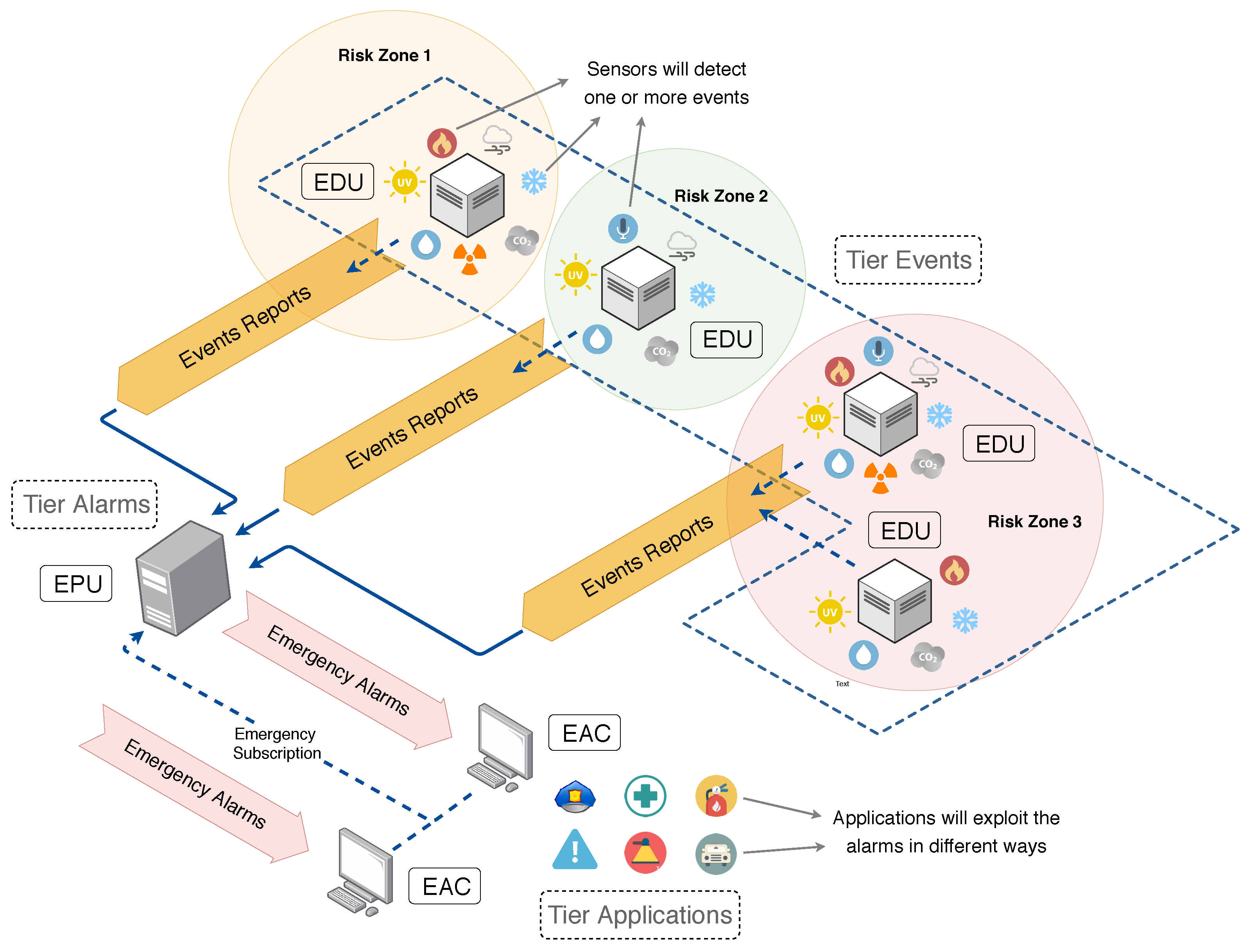
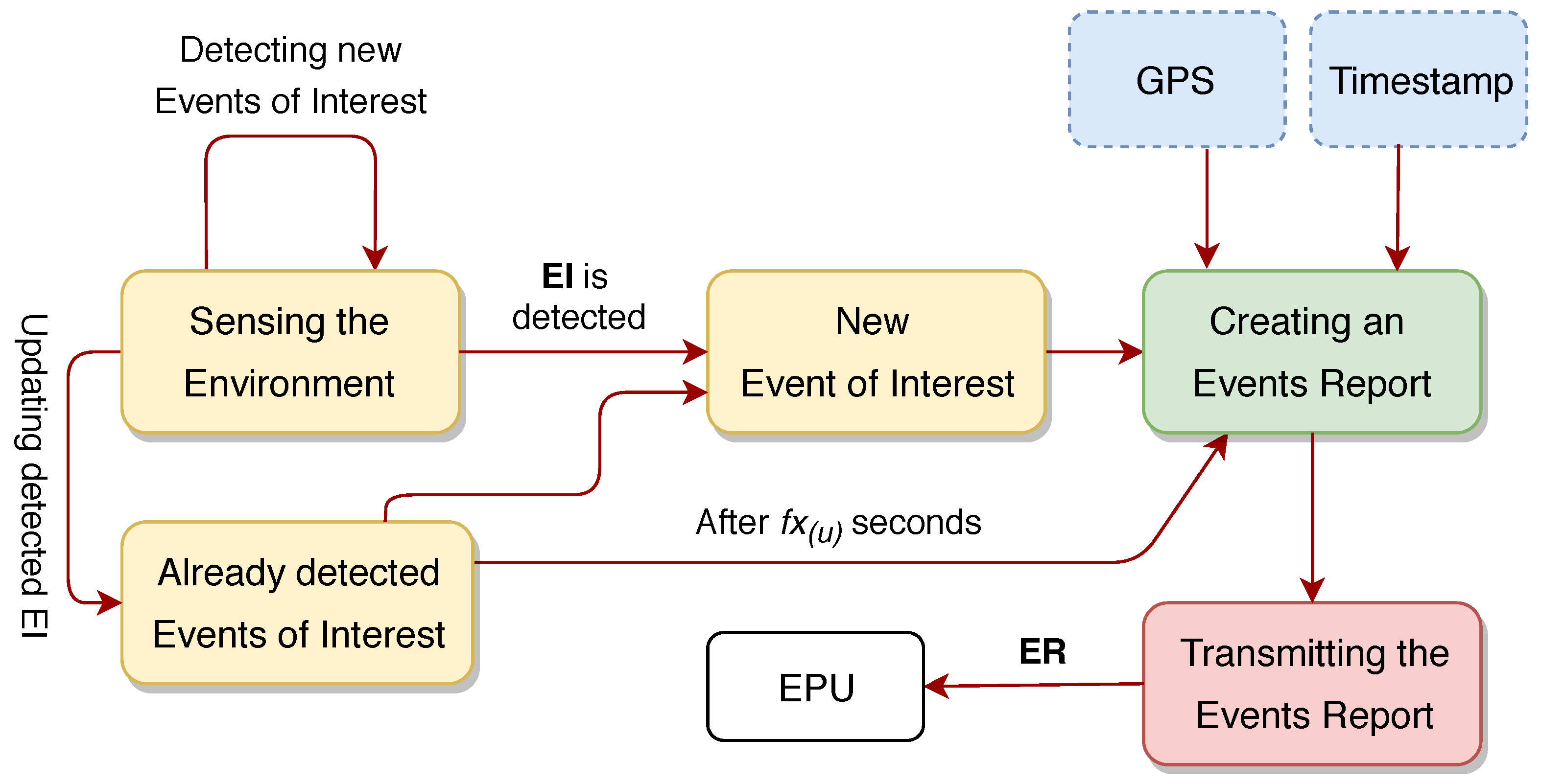
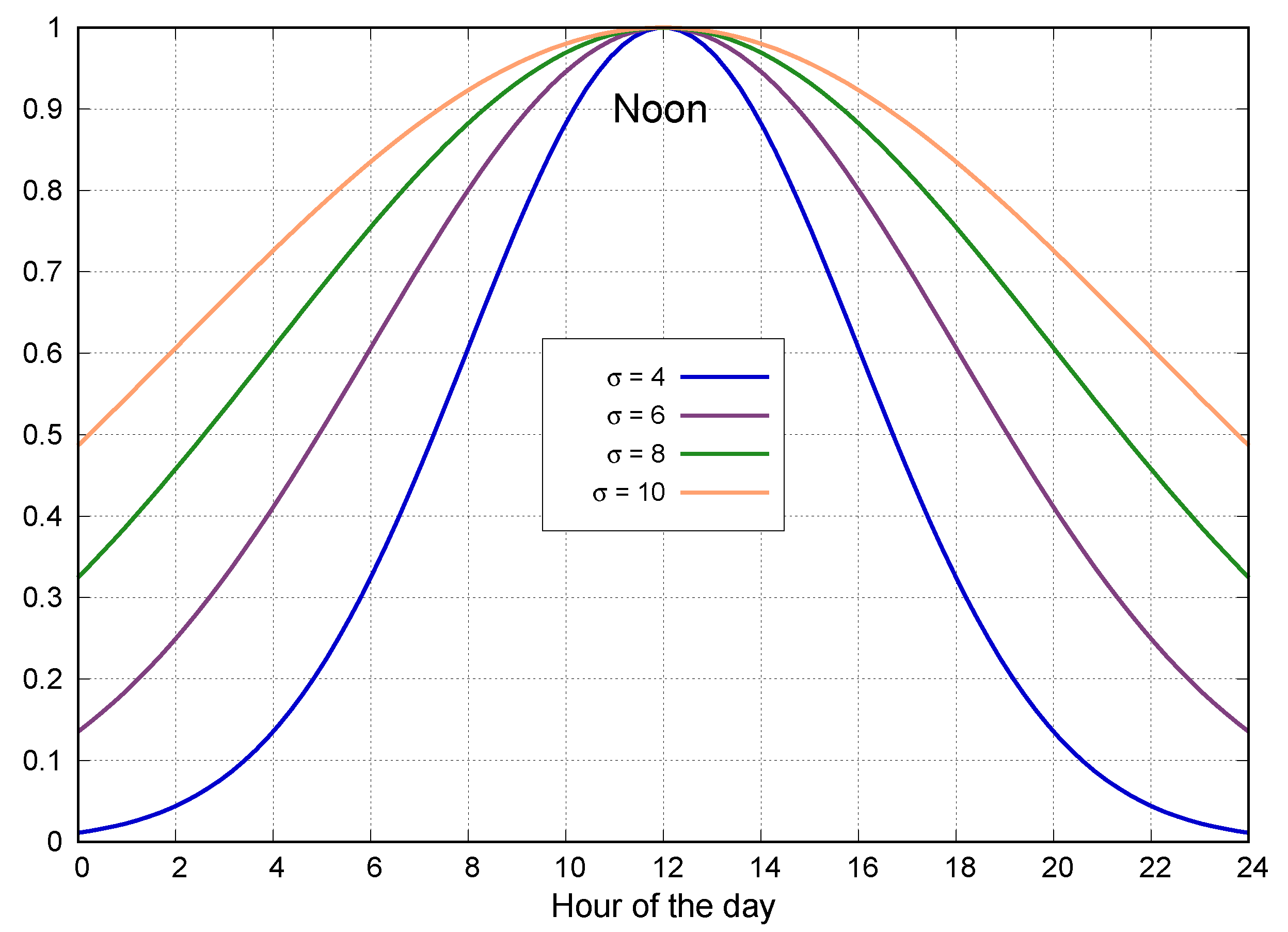
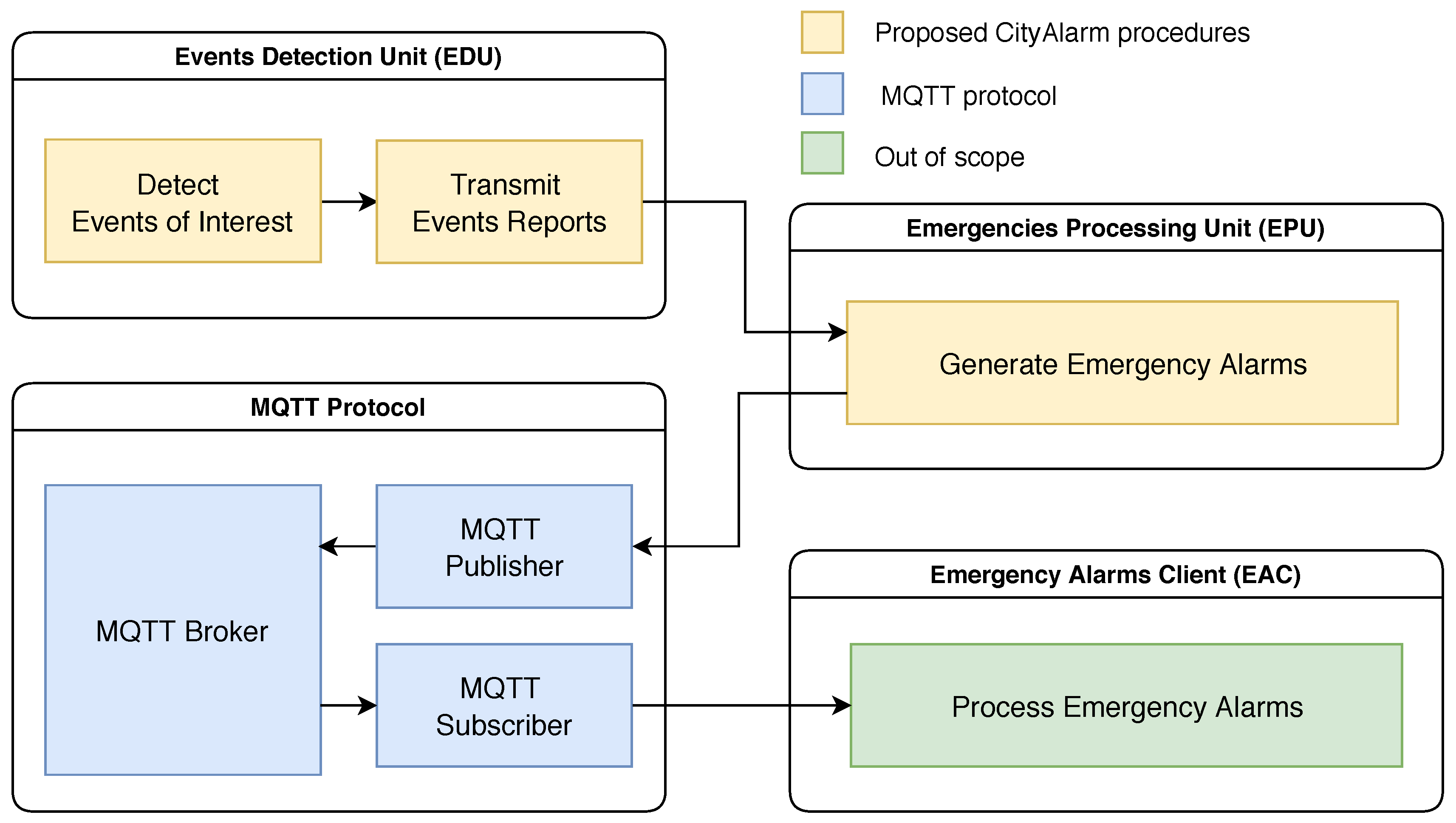
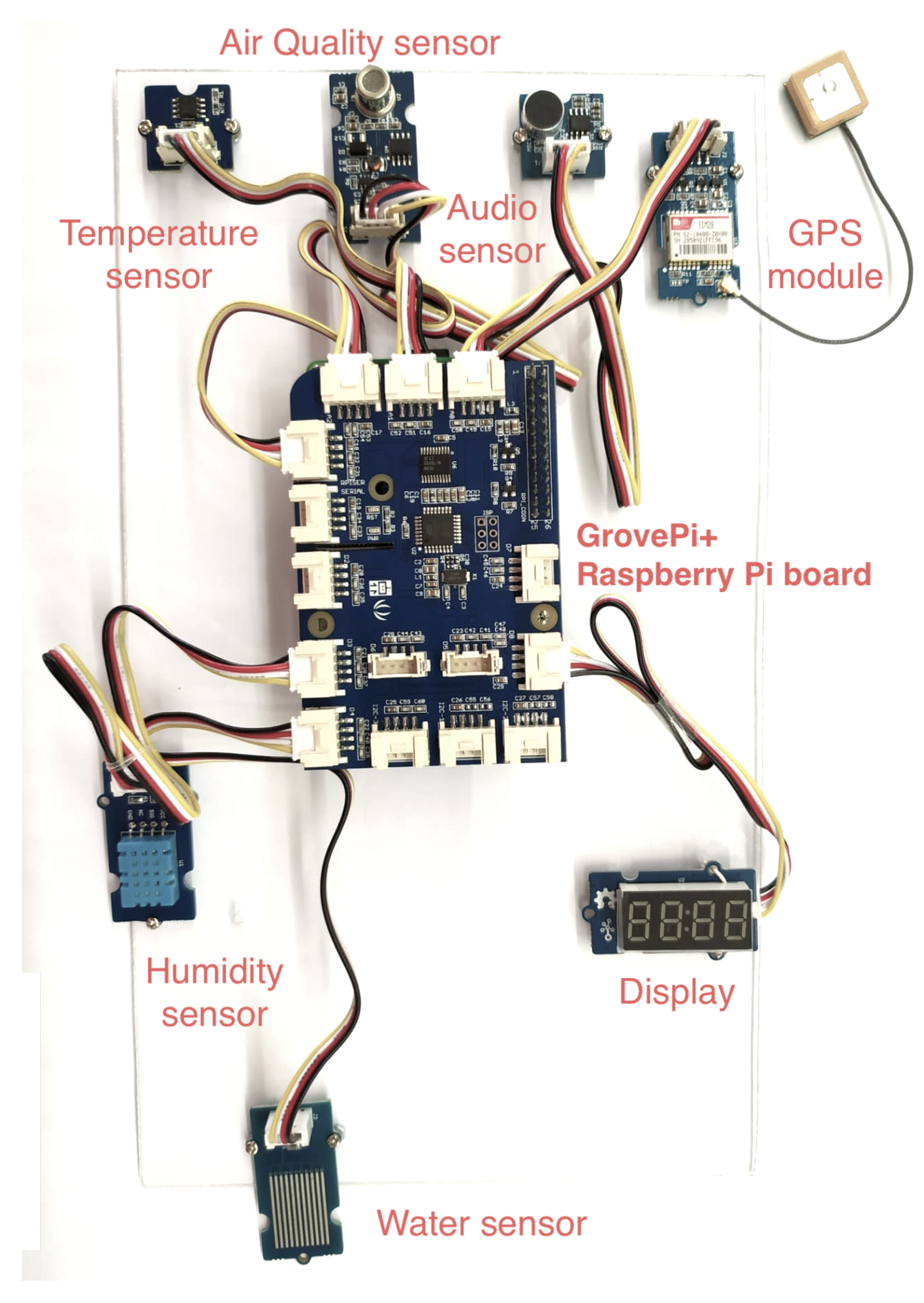
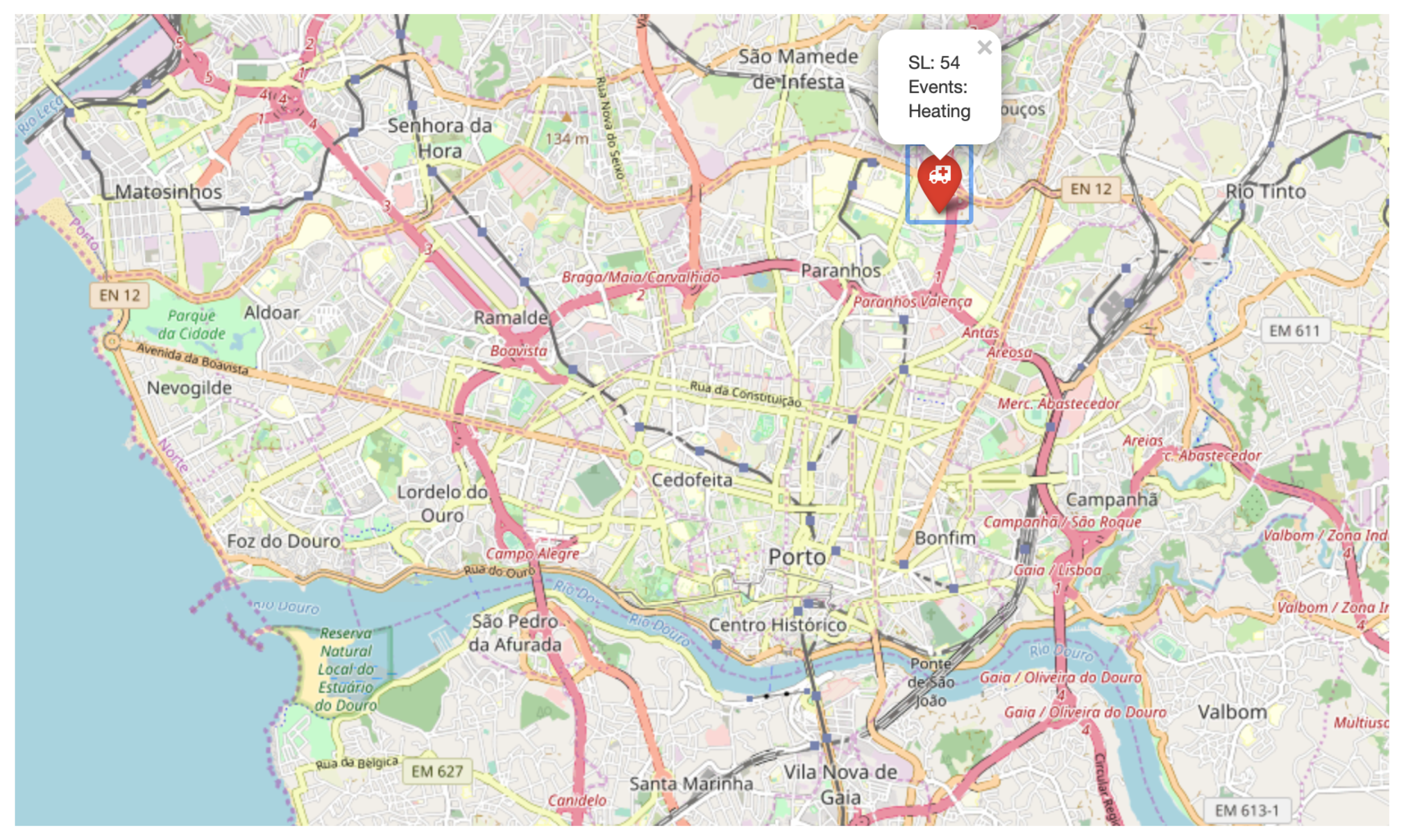
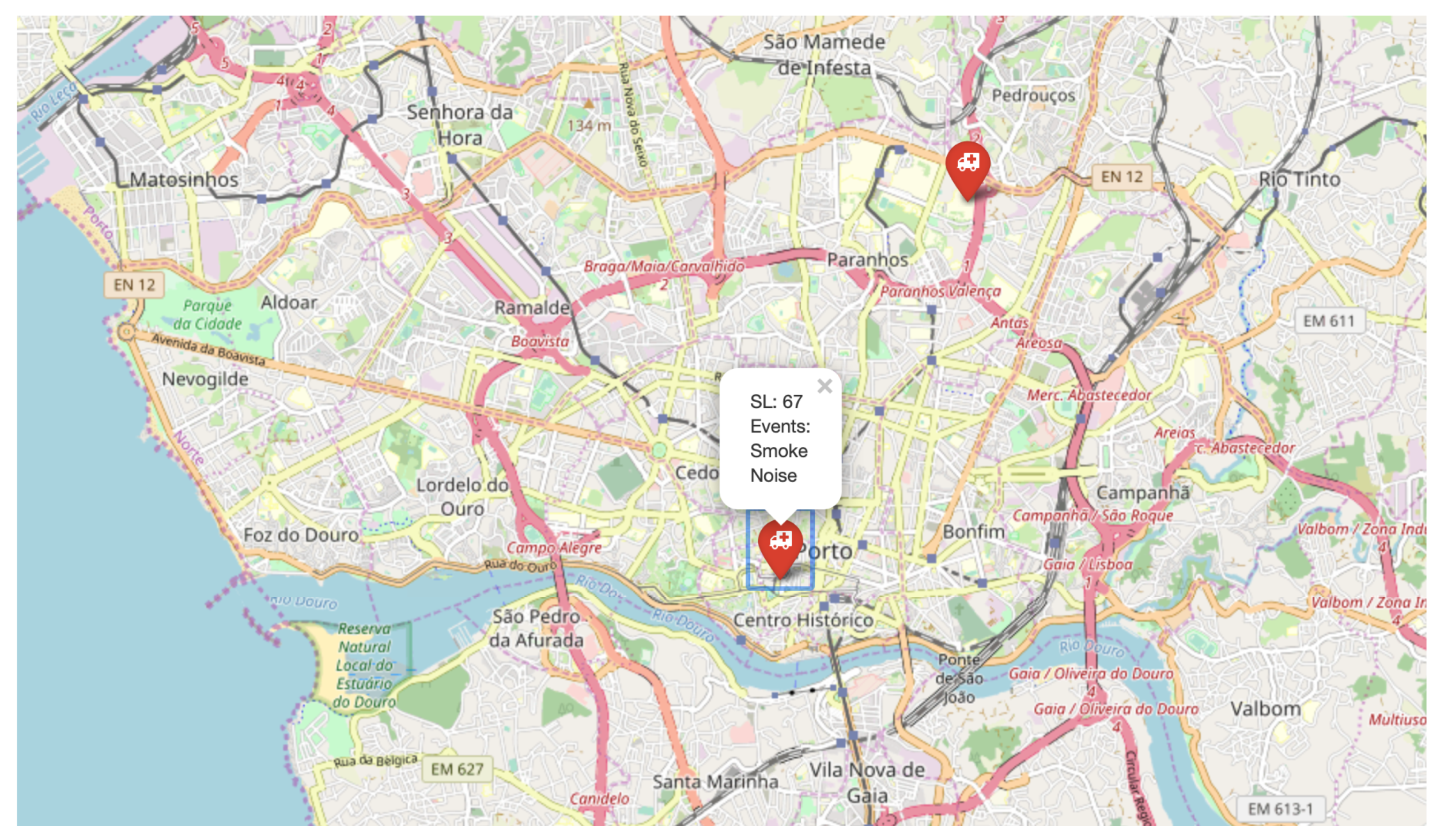
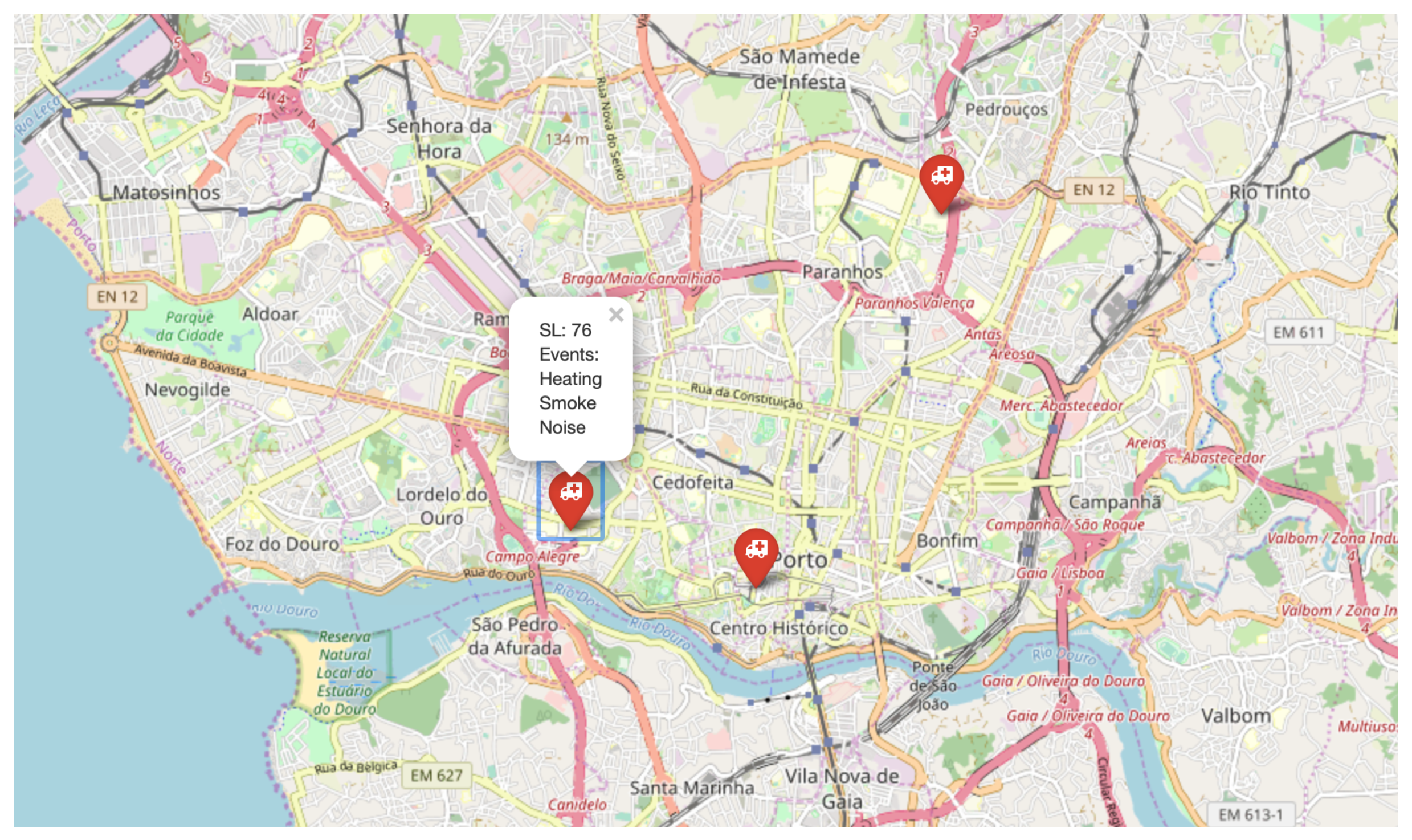
| Event Description | Scalar Data | Type (y) | Threshold () |
|---|---|---|---|
| Heating | Temperature | 1 | °C |
| Freezing | Temperature | 2 | °C |
| Low Humidity | Relative humidity | 3 | |
| Smoke | C0 concentration | 4 | ppm |
| Toxic Gases (leakage) | Ammonia (NH) | 5 | ppm |
| Heavy Rain | Rain precipitation | 6 | mm/h |
| Earthquake | Seismic magnitude | 7 | M |
| Noise Pollution | Audio signal strength | 8 | dB |
| Dangerous Radiation | Radiation | 9 | rad |
| Blast Wave | Air pressure (or wind speed) | 10 | psi |
| Strong Wind | Wind speed | 11 | km/h |
| Low Luminosity | Light intensity | 12 | Lux |
| Heavy Snowing | Snowfall | 13 | cm/day |
| Dangerous Dam Level | Dam water level | 14 |
| Component | Model | Description |
|---|---|---|
| Raspberry Pi | 3B+ | Main processing board |
| GrovePi+ | v3.0 | Sensors integration board |
| GPS module | v1.2 | Retrieves latitude and longitude |
| Display module | v1.0 | Displays the number of detected EI |
| Temperature sensor | v1.2 | Temperature from to |
| Humidity sensor | v1.2 | Relative humidity from to |
| Audio sensor | v1.6 | From 0 a 1023; can be converted to dB |
| Water sensor | v1.1 | Two states: 1 (dry) and 0 (wet) |
| Air Quality sensor | v1.2 | From 0 to 1000 |
© 2019 by the authors. Licensee MDPI, Basel, Switzerland. This article is an open access article distributed under the terms and conditions of the Creative Commons Attribution (CC BY) license (http://creativecommons.org/licenses/by/4.0/).
Share and Cite
Costa, D.G.; Vasques, F.; Portugal, P.; Aguiar, A. A Distributed Multi-Tier Emergency Alerting System Exploiting Sensors-Based Event Detection to Support Smart City Applications. Sensors 2020, 20, 170. https://doi.org/10.3390/s20010170
Costa DG, Vasques F, Portugal P, Aguiar A. A Distributed Multi-Tier Emergency Alerting System Exploiting Sensors-Based Event Detection to Support Smart City Applications. Sensors. 2020; 20(1):170. https://doi.org/10.3390/s20010170
Chicago/Turabian StyleCosta, Daniel G., Francisco Vasques, Paulo Portugal, and Ana Aguiar. 2020. "A Distributed Multi-Tier Emergency Alerting System Exploiting Sensors-Based Event Detection to Support Smart City Applications" Sensors 20, no. 1: 170. https://doi.org/10.3390/s20010170
APA StyleCosta, D. G., Vasques, F., Portugal, P., & Aguiar, A. (2020). A Distributed Multi-Tier Emergency Alerting System Exploiting Sensors-Based Event Detection to Support Smart City Applications. Sensors, 20(1), 170. https://doi.org/10.3390/s20010170








